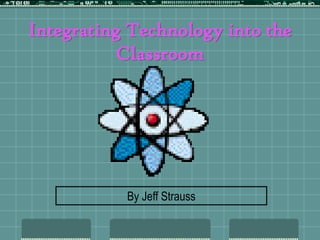
Integrating Technology Into The Classroom
- 1. Integrating Technology into the Classroom
- 2. Two Main Components of Computers Hardware Software
- 3. Software and Mediums Drill and Practice Software (CBI) Computer Aided Instruction (CAI) Tool Software (Productivity Software) Word Processors, PowerPoint, Spreadsheets, Database Telecommunication The Internet Simulation Software
- 7. Memory & Storage ROM Read Only Memory. This is Typically found on your hard drive RAM Random Access Memory Drives This can be your hard drive, floppy, Zip drive, CD drive, or USB flash drive
- 8. Working With Memory Floppy Disk 1.44 MB Zip Disks 100MB, 250MB, 750MB CD ROMS 750MB (Can be Read only or Read-Write) USB Flash Drives 32MB – 1Gigabyte RAM 64MB – 2Gigabyte Hard drive 20 – 200 Gigabytes
- 9. Understanding Memory Capacity BIT = Binary digIT This is by definition the smallest unit of data that a computer can recognize. Byte = 8 BITS It requires eight bits to make up one byte, and one byte equals one character, such as the letter "a" or the numeral "7."
- 10. Kilobyte = 1,000 bytes and is abbreviated K or KB Megabyte = is 1 million bytes and is abbreviated MB. So if you see a file size that's 1,714KB, mentally add three zeros to the number so it becomes 1,714,000, and that's 1.7MB or 1.7 million bytes Gigabyte = 1,000 megabytes and is abbreviated GB. Ultra cool computer dudes and dudesses refer to gigabytes as "gigs," but we civilized folk refer to "gigabytes," thankyouverymuch !
- 11. Peripherals Input Devices Mouse Keyboard Scanner Cameras/Videos Storage Drives i.e. Floppies, CDs, DVDs, Zips, USB drives Modem- Internet Connections & Network Connections Output Devices Computer Screen Printers Servers/Internet
- 12. Software And How it Works
- 13. Operating Systems The original version of MS-DOS. This was a renamed version of QDOS which had been purchased by an upstart company called Microsoft. It was in 1981 and was version 1.0 It was invented by a man named Gary Kildall and was actually developed for IBM’s PC. But he sold the operating system to a man named Bill Gates for $50,000 outright. The problem for most of us is that this is a programming environment and not very user friendly. So it was the advent of Windows that set Microsoft up to own the world and supply the operating system for over 95% of the world’s PCs While MS DOS still runs “underneath” of windows it is the “GUI” environment that revolutionized personal computing. (Graphical User Interface) So the icon or title in the programs menu that you click on is “interfacing” actually acting as the intermediary with the DOS code and executing it for you. So the computer is still following the actual DOS prompt.
- 14. Software Applications Windows and MS DOS are just find but all they do is run the computer. They move the input like the Keyboard to the output device like the monitor or the printer. We next tackle the issue of productivity programs. We will be focusing on Microsoft Office
- 15. Microsoft Office Word Excel PowerPoint Access Publisher FrontPage Outlook
- 16. The Internet The Information Superhighway
- 17. What is the Internet? The Internet is a worldwide system of computer networks - a network of networks in which users at any one computer can potentially get information from any other computer in the world. The Internet currently has around 196 million users (projections for 2003 estimate that there will be about 225 million users).
- 18. What is the World Wide Web (WWW)? The WWW, or Web as it has become known, is becoming synonymous with the Internet, but unlike the Internet it is not a physical entity. More simply, it is a collection of programs and services that make up the attractive & appealing user friendly face of the Internet.
- 19. Access to the InternetIs through a web “browser”
- 20. What is a Web Browser? A web browser is a piece of software, such as Netscape Navigator or Microsoft Internet Explorer, running on a user's machine which interprets requested documents. These documents can include text, images, video and audio and are displayed in the browser which is a graphical user interface.
- 21. Other Info Regarding the Internet What is a Hyperlink?Exactly what you just did to get here. In the browser you will notice that if you move the mouse pointer over text/images it changes to a finger. If you click on the object it links you to another location/document, hence the term Hyperlink. What is HTML? Hyper Text Markup Language (HTML) A protocol used on the Internet which defines how documents are presented.
- 22. When Dealing With Children and the Internet Safety
- 23. Sites for Internet Safety http://www.nheon.com/netsmartz/ http://www.safekids.com/child_safety.htm http://safety.ngfl.gov.uk/ http://yahooligans.yahoo.com/parents__guide/browsers_for_kids/ http://www.childnet-int.org/
- 24. Issues about Technology in the Classroom Barriers to Change
- 25. 1st Order Barriers are “Extrinsic” and generally are a Lack of: Access to hardware Access to software Time to plan instruction Technical support Administrative support
- 26. 2nd Order Barriers are “Intrinsic” and generally are hidden within the 1st Order Barriers Beliefs about teaching Beliefs about technology Organizational context Lack of instructional models Unwillingness to change
- 27. How will student training be handled? Who will supervise students as they use the technology? Who will have access to the technology? Who will determine priority of use? How will software and hardware be scheduled? Who will be responsible for maintenance? How much will be budgeted for maintenance? How will worn out hardware be replaced? Integrating Technology
- 28. Integrating Computer Software - The Importance of Planning A Model to ASSURE Learning Analyze audience. Set goals and state objectives. Select software and methods. Utilize materials. Require learner participation. Evaluate.